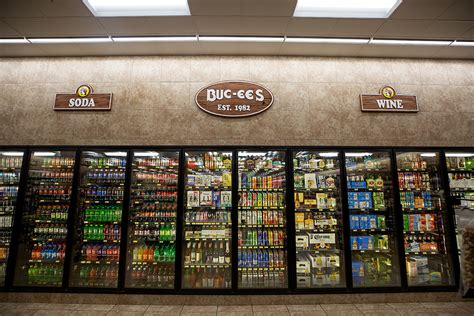
Buc-ee’s, the beloved Texas-based travel center chain, is conspicuously missing Coca-Cola products from its vast beverage selection, opting instead for its own private-label cola and Dr. Pepper alternative, Dr. B. This strategic decision, driven by factors including profit margins, brand control, and a desire to cultivate a unique identity, has left many customers wondering about the absence of the ubiquitous soft drink giant.
The absence of Coca-Cola products in Buc-ee’s stores isn’t an oversight but a deliberate business strategy. While Buc-ee’s officials have remained tight-lipped regarding the specifics of their relationship with Coca-Cola, industry experts suggest that the decision stems from a combination of financial incentives and brand management considerations. By stocking its private-label beverages, Buc-ee’s can secure higher profit margins compared to selling name-brand products. Private-label brands typically offer retailers a greater degree of control over pricing and supply chains, enabling them to maximize their profitability.
“It’s about profit margins,” explains retail analyst John Anderson. “Private-label brands generally offer retailers a higher profit margin than name-brand products. By selling their own cola and Dr. Pepper alternative, Buc-ee’s can keep a larger portion of the revenue.”
In addition to increased profitability, the decision to forgo Coca-Cola products allows Buc-ee’s to cultivate a unique brand identity. By offering its own exclusive products, the company can differentiate itself from competitors and create a sense of exclusivity that enhances its brand appeal. The absence of Coca-Cola, a brand readily available at countless other retailers, contributes to the novelty and distinctiveness of the Buc-ee’s shopping experience. This unique identity helps foster customer loyalty and reinforces the perception of Buc-ee’s as a destination unlike any other.
The strategy aligns with Buc-ee’s broader approach to building a distinctive brand experience. From its meticulously clean restrooms to its vast selection of snacks, jerky, and souvenirs, Buc-ee’s strives to create a memorable and enjoyable shopping environment. The absence of Coca-Cola, while perhaps surprising to some, is simply another element of this carefully crafted brand strategy. It underscores Buc-ee’s commitment to doing things differently and creating a unique identity in the competitive retail landscape.
The company’s foray into private-label beverages is not new. Buc-ee’s has successfully implemented this strategy across various product categories, offering its own branded snacks, sauces, and merchandise. This approach allows them to control the quality, pricing, and presentation of these products, ensuring they align with the company’s overall brand image. The success of these private-label offerings likely contributed to the decision to extend the strategy to the beverage category.
The choice to offer Dr. B, a Dr. Pepper alternative, is particularly noteworthy. Dr. Pepper enjoys immense popularity in Texas, where Buc-ee’s has its roots and strongest presence. By offering a similar product under its own brand, Buc-ee’s caters to local tastes while simultaneously capturing a portion of the market share that would otherwise go to Dr. Pepper. This strategic move demonstrates the company’s understanding of its customer base and its willingness to tailor its product offerings to regional preferences.
The absence of Coca-Cola products has not appeared to negatively impact Buc-ee’s popularity. The travel centers continue to draw massive crowds, attracted by their clean facilities, wide selection of products, and overall unique shopping experience. In fact, the absence of Coca-Cola may even contribute to the stores’ allure, adding to the sense of novelty and exclusivity that sets them apart from other retailers. Customers who are accustomed to finding Coca-Cola products everywhere else may view the absence of the brand at Buc-ee’s as a quirky and memorable detail that enhances the overall experience.
Buc-ee’s strategic decision reflects a broader trend in the retail industry, where private-label brands are gaining increasing prominence. Retailers are recognizing the benefits of offering their own branded products, including increased profitability, greater control over supply chains, and enhanced brand differentiation. As consumers become more price-conscious and more willing to try alternative brands, the popularity of private-label products is likely to continue to grow.
While Buc-ee’s has not publicly addressed the reasons behind its decision, the available evidence suggests that it is a calculated move designed to maximize profitability, cultivate a unique brand identity, and cater to local tastes. The absence of Coca-Cola may be surprising to some, but it is ultimately a reflection of Buc-ee’s commitment to doing things differently and creating a distinctive shopping experience that sets it apart from the competition. It’s a business decision rooted in economics and branding, designed to further solidify Buc-ee’s unique position in the market.
The implications of this strategy extend beyond just the beverage aisle. It signifies a broader trend in retail where companies are increasingly willing to challenge established brands and offer their own private-label alternatives. This trend is driven by a combination of factors, including increased consumer acceptance of private-label products, advancements in manufacturing and supply chain management, and the desire of retailers to enhance their profitability and brand differentiation. Buc-ee’s decision to forgo Coca-Cola products is a prime example of this trend in action.
Buc-ee’s success underscores the importance of creating a compelling brand experience. The company has built a loyal following by offering clean facilities, a wide selection of products, and a fun and engaging shopping environment. The absence of Coca-Cola, while seemingly minor, is just one element of this carefully crafted brand experience. It demonstrates the company’s attention to detail and its willingness to make unconventional choices that set it apart from the competition.
The retail landscape is constantly evolving, and companies must adapt to changing consumer preferences and market conditions in order to thrive. Buc-ee’s decision to forgo Coca-Cola products is a testament to the company’s willingness to innovate and experiment. By offering its own private-label beverages, Buc-ee’s is not only increasing its profitability but also reinforcing its brand identity and creating a more distinctive shopping experience for its customers.
The situation also raises questions about the power dynamics between retailers and major brands. In the past, large beverage companies like Coca-Cola held significant sway over retailers, dictating pricing and product placement. However, as retailers have grown in size and sophistication, they have gained more leverage in these negotiations. Buc-ee’s decision to forgo Coca-Cola products suggests that retailers are increasingly willing to assert their independence and make choices that are in their own best interests, even if it means challenging established brands.
Buc-ee’s continues to expand its reach, opening new stores in new states and attracting even more customers. As it grows, the company’s brand strategy will likely evolve. It will be interesting to see how Buc-ee’s navigates the changing retail landscape and whether it continues to offer its own private-label beverages or eventually decides to stock Coca-Cola products. Regardless of its future decisions, Buc-ee’s has already demonstrated its ability to disrupt the retail industry and create a unique brand experience that resonates with consumers. The absence of Coca-Cola is just one piece of this puzzle, but it is a significant piece that underscores the company’s commitment to doing things differently and challenging the status quo.
Buc-ee’s stands as a testament to the power of building a strong brand identity. Their success is not solely based on low prices or product availability, but on creating an experience that customers value and are willing to travel for. The clean restrooms, the wide array of snacks and merchandise, and the overall atmosphere of the stores all contribute to this experience. The absence of Coca-Cola, while not a defining factor, is a subtle reminder that Buc-ee’s is not just another gas station or convenience store. It is a destination.
In conclusion, the absence of Coca-Cola products at Buc-ee’s is a strategic business decision driven by a combination of factors, including increased profit margins, brand control, and a desire to cultivate a unique identity. While the specifics of the relationship between Buc-ee’s and Coca-Cola remain undisclosed, industry analysts suggest that the move reflects a broader trend in retail where private-label brands are gaining increasing prominence. The absence of Coca-Cola does not appear to have negatively impacted Buc-ee’s popularity, and may even contribute to the stores’ allure, adding to the sense of novelty and exclusivity that sets them apart from other retailers. It’s a calculated risk that appears to be paying off, further solidifying Buc-ee’s position as a unique and beloved travel destination.
The story is a reminder that even in a world dominated by global brands, there is still room for innovation and differentiation. Buc-ee’s has proven that by focusing on the customer experience and by being willing to challenge the status quo, a company can build a loyal following and achieve significant success. The absence of Coca-Cola may be a minor detail in the grand scheme of things, but it is a detail that speaks volumes about Buc-ee’s commitment to doing things its own way.
The impact of Buc-ee’s decision extends beyond its own stores. It serves as an example to other retailers who are considering launching their own private-label brands. It shows that it is possible to compete with established brands and that consumers are increasingly willing to try alternative products. As the retail landscape continues to evolve, we can expect to see more and more retailers following Buc-ee’s lead and offering their own unique and innovative products.
Buc-ee’s also uses a combination of data analysis and customer feedback to continuously refine its product offerings. This allows them to identify trends and preferences and to tailor their product selection to meet the specific needs of their customers. By paying close attention to what their customers want, Buc-ee’s is able to create a shopping experience that is both enjoyable and convenient.
Furthermore, Buc-ee’s investment in infrastructure is evident. The size and layout of Buc-ee’s stores are designed to accommodate large volumes of customers, especially during peak travel times. The company also invests heavily in maintaining clean restrooms and providing ample parking, which are key factors in attracting and retaining customers. The attention to detail and the commitment to providing a positive shopping experience are what set Buc-ee’s apart from other travel centers.
The impact on other retailers in the travel center and convenience store sectors is also noteworthy. Buc-ee’s has raised the bar for customer service, cleanliness, and product selection. Other retailers are now under pressure to improve their own offerings in order to compete with Buc-ee’s. This has led to a general improvement in the quality of travel centers and convenience stores across the country, benefiting consumers.
The company’s success is also attributable to its strong company culture. Buc-ee’s is known for its high standards and its commitment to providing excellent customer service. The company invests in training and development for its employees, ensuring that they are knowledgeable, friendly, and helpful. This creates a positive work environment and contributes to the overall positive shopping experience for customers.
The Buc-ee’s phenomenon has also had an impact on the communities where its stores are located. The company’s stores generate significant economic activity, creating jobs and boosting local tax revenues. Buc-ee’s also supports local charities and community organizations, further contributing to the well-being of the communities where it operates. The company’s success is not just about making money; it is also about giving back to the community.
Looking ahead, it will be interesting to see how Buc-ee’s continues to innovate and adapt to the changing retail landscape. The company has already demonstrated its ability to disrupt the industry and create a unique brand experience that resonates with consumers. As it expands its reach and opens new stores in new markets, Buc-ee’s will undoubtedly continue to challenge the status quo and set new standards for the travel center and convenience store sectors.
The Buc-ee’s story provides valuable lessons for other businesses, regardless of their industry. It demonstrates the importance of building a strong brand identity, focusing on the customer experience, and being willing to challenge the status quo. By following these principles, businesses can create a loyal following and achieve significant success, even in a highly competitive market. The absence of Coca-Cola at Buc-ee’s is a small detail, but it is a detail that encapsulates the company’s unique approach to business and its commitment to providing a distinctive shopping experience.
Buc-ee’s model also focuses on high volume. The stores are designed to handle a large number of customers efficiently, with multiple checkout lanes and well-stocked shelves. This allows Buc-ee’s to generate significant revenue, even with relatively low profit margins on individual items. The high-volume approach is a key component of the company’s success.
Another critical element is the location strategy. Buc-ee’s stores are typically located along major highways and interstates, making them easily accessible to travelers. The company also carefully selects locations that are underserved by other retailers, ensuring that its stores are in high demand. The strategic location of Buc-ee’s stores is a key factor in their success.
The company also emphasizes employee retention. Buc-ee’s is known for offering competitive wages and benefits, which helps to attract and retain talented employees. This reduces turnover and ensures that the company has a skilled and experienced workforce. The emphasis on employee retention is a key factor in Buc-ee’s ability to provide excellent customer service.
Buc-ee’s has also become a social media phenomenon. Customers frequently share their experiences at Buc-ee’s on social media platforms, generating free advertising for the company. The social media buzz has helped to increase Buc-ee’s brand awareness and attract even more customers. The company’s unique brand and offerings naturally lend themselves to being shared online, creating a viral effect.
The Buc-ee’s story is a fascinating case study in retail innovation and brand building. It demonstrates that it is possible to create a successful business by focusing on the customer experience, challenging the status quo, and building a strong company culture. The absence of Coca-Cola at Buc-ee’s is just one small piece of the puzzle, but it is a piece that underscores the company’s unique approach to business and its commitment to providing a distinctive shopping experience. It also represents a power shift in the retail landscape, where retailers are increasingly willing to assert their independence and make choices that are in their own best interests.
Frequently Asked Questions (FAQ) about Buc-ee’s and Coca-Cola:
1. Why doesn’t Buc-ee’s sell Coca-Cola products?
The primary reasons are believed to be higher profit margins from private-label brands like Buc-ee’s cola and Dr. B, enhanced brand control allowing Buc-ee’s to cultivate a unique shopping experience, and potentially strategic disagreements on pricing or distribution with Coca-Cola. While Buc-ee’s has not publicly stated the specific details, analysts suggest these factors contribute to the absence of Coke products.
2. What is Dr. B, and why does Buc-ee’s offer it?
Dr. B is Buc-ee’s private-label alternative to Dr. Pepper, a popular soft drink, especially in Texas where Buc-ee’s has a strong presence. Offering Dr. B allows Buc-ee’s to capture a portion of the Dr. Pepper market while maintaining higher profit margins and promoting its own brand. It is a strategically designed product aimed at local tastes.
3. Does the absence of Coca-Cola affect Buc-ee’s popularity or sales?
No, the absence of Coca-Cola does not appear to have negatively impacted Buc-ee’s popularity or sales. The travel centers continue to draw large crowds due to their clean facilities, wide selection of products, unique shopping experience, and overall brand appeal. In fact, the absence of Coke may contribute to Buc-ee’s distinctive identity.
4. Are there other major brands that Buc-ee’s doesn’t carry?
While the absence of Coca-Cola is the most discussed, Buc-ee’s focuses on curating a specific product selection that aligns with its brand identity and profit goals, meaning they might limit the presence of other major brands in certain categories in favor of their private-label alternatives or partnerships with smaller brands. They strategically choose items and brands that reflect their overall market strategy.
5. Will Buc-ee’s ever start selling Coca-Cola products in the future?
It’s impossible to say definitively. Buc-ee’s business strategies are subject to change based on market conditions, negotiations with suppliers, and evolving consumer preferences. If the financial or strategic benefits outweigh the current advantages of not carrying Coca-Cola, Buc-ee’s could potentially stock their products in the future, but there are no current indications this will happen. The decision will be based on what best aligns with their business goals and brand strategy at that time.









